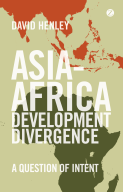Asia–Africa Development Divergence: A question of intent

David Henley, Professor of Contemporary Indonesia Studies at Leiden University, here tackles a thorny question: Why have sub-Saharan Africa and South-East Asia experienced such divergent development paths in the past half-century? That is, in 1960 South-East Asia was much poorer than sub-Saharan Africa. Yet over the past decades South-East Asia has seen far greater improvements in economic growth, poverty reduction, life expectancy, and other indicators. Observers have offered a great many explanations for this: distinct colonial patterns, industrialization, corruption, culture, aid dependence, authoritarianism, geography, ethnic diversity, institutions, etc. Henley discounts all of these.
Henley’s method is to pair countries, one from each region, that faced similar development challenges in the 20th century: Nigeria/Indonesia, Kenya/Malaysia and Tanzania/Vietnam. He looks for turning points at which one country’s economic and social indicators began to dramatically outstrip the other’s. He then analyses the factors leading to those transformations.
The conclusion reached in Asia–Africa Development Divergence is that South-East Asia’s performance has depended on simultaneously meeting three conditions: macroeconomic stability, economic freedom, and pro-poor public spending (on peasant agriculture and rural infrastructure). Of the three, the last is central. Henley argues that it has been difficult to convert economic gains into poverty reduction without focusing on rural development, which has been essential to food production. Leaders in sub-Saharan Africa since decolonization have neglected this, according to the book, in favour of a more Westernized model that embraces technological and cultural “modernization”, including a focus on urban areas. This focus is partly related to ideology, and partly to the backgrounds of the African leaders. Thus, Henley emphasises, a change in mindset is needed.
This is a perhaps controversial perspective. For instance, Henley’s theory runs counter to the notion that export-oriented industrialization has been responsible for the economic growth of the “Asian tigers”. Also contentious is Henley’s call for “rural bias” in the future policy of sub-Saharan Africa. It will be interesting to see how others engage with these ideas.
Further reading:
Kessides, Christine (2005), “The Urban Transition in Sub-Saharan Africa: Implications for Economic Growth and Poverty Reduction”, Africa Region Working Paper Series No. 97, World Bank, available at http://www.worldbank.org/afr/wps/wp97.pdf.
Tacoli, Cecilia (2006), The Earthscan Reader in Rural-Urban Linkages, 329 pages, IIED and Routledge, available at http://www.routledge.com/books/details/9781844073160/.
Book note prepared by Christine Ro
Search the Book notes database
Our Book notes database contains details and summaries of all the publications included in Book notes since 1993 - with details on how to obtain/download.
Use the search form above, or visit the Book notes landing page for more options and latest content.
For a searchable database for papers in Environment and Urbanization, go to http://eau.sagepub.com/

